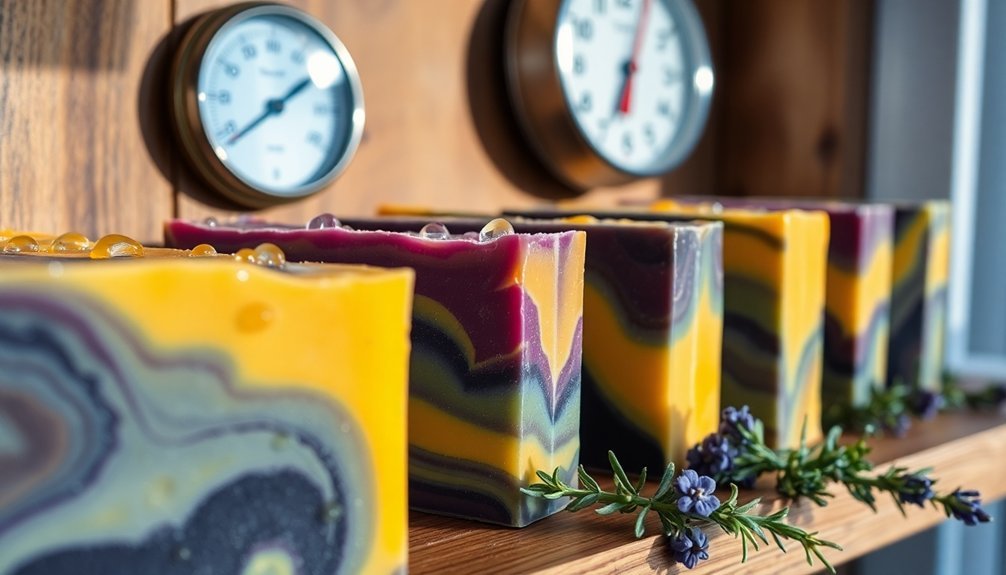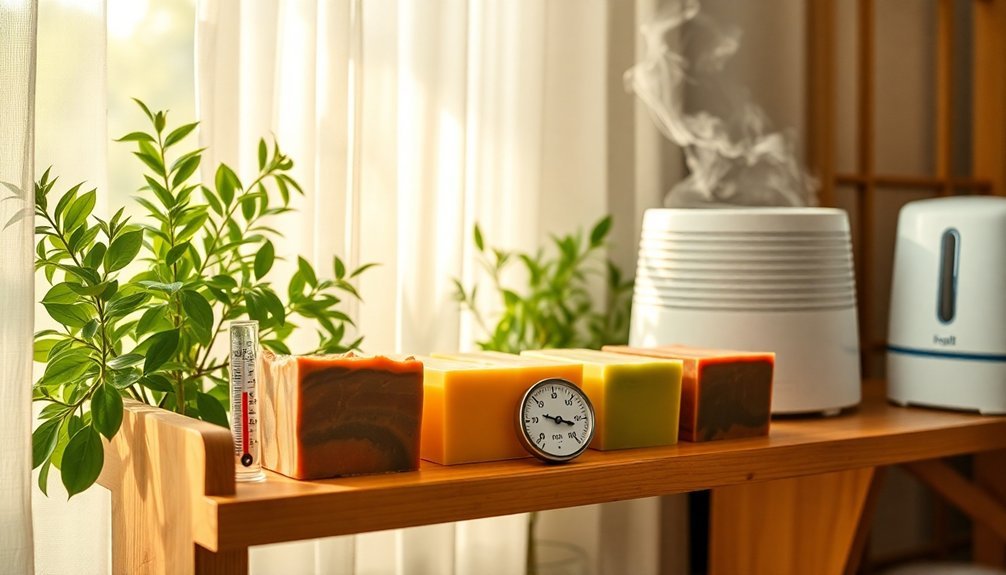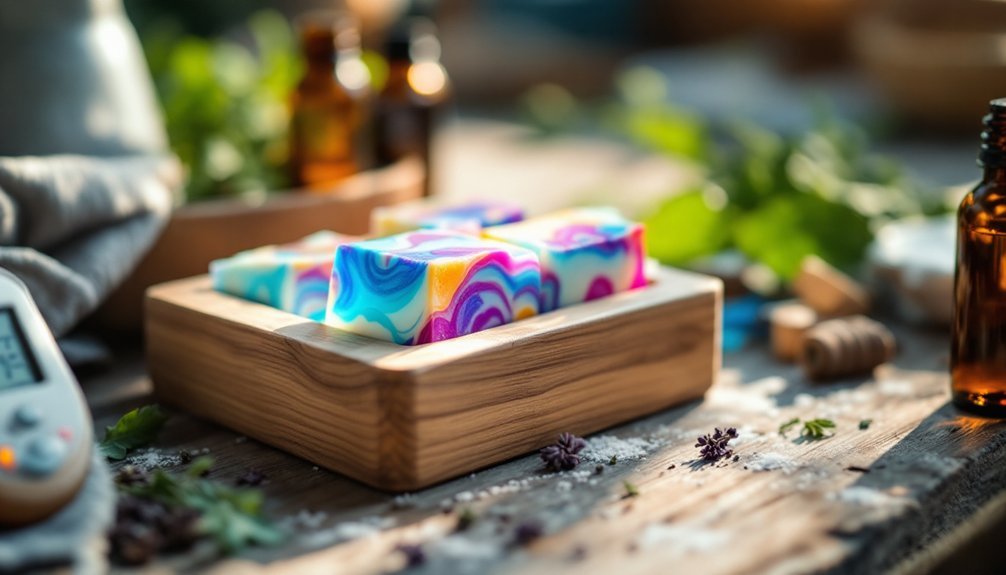Cold process soap should cure at a consistent 65-75°F (18-24°C), with room temperature (68-72°F) being ideal. You'll want to maintain humidity between 40-60% with good airflow around your bars using wire racks. Keep soap away from drafts, temperature fluctuations, and direct sunlight. Seasonal changes affect curing speeds—faster in summer, slower in winter—so creating a stable environment guarantees quality results. Mastering these temperature conditions transforms good soap into exceptional bars.
The Science Behind Ideal Curing Temperatures

While the initial mixing of cold process soap happens at temperatures around 100°F, the curing process requires different temperature considerations altogether. The curing environment greatly impacts your soap's final quality and longevity.
During curing, water evaporates from your soap bars, allowing them to harden properly and develop stable lather. You'll want to maintain a consistent ambient temperature between 65-75°F (18-24°C) for the best results.
The magic happens at 65-75°F, where evaporation transforms your bars into perfectly hardened, lather-rich soap.
Temperatures that are too high can cause oils to become rancid prematurely, while excessively cold environments slow down the curing process. This aligns with cold process soap's emphasis on preserving beneficial properties found in natural ingredients.
Proper temperature stability during curing guarantees complete saponification and prevents issues like warping or condensation.
As your soap bars cure, they'll gradually achieve the ideal pH balance, becoming milder and more skin-friendly.
Room Temperature Curing: Finding Your Sweet Spot
Finding the ideal room temperature for curing your cold process soap doesn't require specialized equipment or extreme precision. The standard room temperature range of 68-72°F (20-22°C) provides an excellent environment for your soap to mature properly. Your focus should be on consistency rather than hitting a specific temperature point.
For ideal room temperature curing, consider:
- Maintaining stable temperature conditions to guarantee uniform hardening
- Setting up adequate airflow around your soaps to prevent moisture buildup
- Using wire racks to allow air circulation on all sides of your bars
- Keeping your curing area away from direct sunlight and temperature fluctuations
Remember that environmental factors like humidity will affect your curing process more than small temperature variations. While temperature affects curing aesthetics, cold process soap will cure at the same rate regardless of the ambient temperature.
You'll need to adjust curing time based on your recipe, especially when using slow-curing oils like olive oil.
Managing Airflow and Humidity for Perfect Soap

Effective airflow and humidity management form the foundation of successful cold process soap curing. You'll need to maintain 40-60% humidity levels while ensuring even air distribution around your bars.
Set up your curing area with proper ventilation—use fans or open windows to create consistent airflow. Place soap bars on elevated racks with sufficient space between each one, allowing air to circulate freely around all surfaces. Keep the temperature in your curing area between 90°F to 110°F, which coincides with ideal soap-making temperatures and promotes proper hardening.
Monitor your environment regularly and make adjustments as needed. Use dehumidifiers in damp conditions or humidifiers in overly dry climates.
When preparing soap for storage or shipping, wrap it loosely in breathable materials like paper or cloth to prevent moisture buildup.
Seasonal Temperature Variations and Their Effects
Seasonal changes dramatically impact the cold process soap curing cycle, requiring soapmakers to adapt their techniques throughout the year. Your soap's curing process will speed up in summer and slow down in winter due to temperature's direct effect on saponification rates. Maintaining temperatures close to body temperature helps prevent issues during the curing process regardless of season.
Just as nature transitions through seasons, your soap curing demands adaptations as temperatures rise and fall throughout the year.
- Spring/Fall Advantage: These moderate seasons offer ideal 70-75°F conditions for balanced curing without special adjustments.
- Summer Challenges: Protect your soap from overheating by curing in cooler areas and monitoring for cracks that develop when saponification occurs too rapidly.
- Winter Adjustments: Compensate for slower reactions by increasing insulation around molds or adjusting lye concentration.
- Year-Round Solutions: Creating a temperature-controlled curing environment helps maintain consistent quality regardless of outdoor conditions.
Building a Controlled Curing Environment at Home

Creating a dedicated space for soap curing at home doesn't require elaborate equipment but demands careful attention to essential environmental factors. Focus on maintaining room temperatures between 68-72°F while ensuring proper air circulation around each bar. After unmolding your soap, establish a consistent curing area where conditions remain stable throughout the 4-6 week curing period.
| Element | Recommendation |
|---|---|
| Air Flow | Use wire racks for even circulation |
| Location | Choose draft-free areas away from direct sunlight |
| Protection | Cover with lightweight materials like parchment paper |
| Monitoring | Track temperature and humidity consistently |
Position your curing rack away from pets and contaminants, allowing at least four weeks for proper curing. Don't store soap in airtight containers as this prevents necessary airflow. Instead, space bars evenly on racks to promote water evaporation. Keeping a simple log of conditions can help you replicate successful batches and adjust for seasonal variations.
Frequently Asked Questions
Can Soaps Cure Safely in Basement or Garage Environments?
Yes, you can cure soaps in basements or garages if they're well-ventilated and dry. They'll cure more slowly in cold environments, so you'll need to extend curing time and check regularly for moisture issues.
Does Soap Weight Affect Optimal Curing Temperature Requirements?
No, your soap's weight doesn't affect ideal curing temperature requirements. You'll still want to maintain 50-75°F regardless of size. However, thicker soaps may need longer curing times to dry properly throughout.
How Do Essential Oils vs. Fragrance Oils Impact Curing Temperatures?
Neither essential oils nor fragrance oils impact your soap's curing temperature requirements. You'll still cure at normal room temperature (70-80°F). The oils may affect scent retention differently, but they don't change ideal curing conditions.
Can Different Fat Compositions Require Different Curing Temperatures?
No, different fat compositions don't require different curing temperatures. You'll still cure your soap at room temperature (70-85°F), regardless of oils used. However, some fats may affect how quickly your soap hardens during curing.
Will Curing at Higher Temperatures Affect Lather Quality?
Higher temperatures won't directly affect your soap's lather quality, but they can accelerate drying. This might create a harder bar sooner, which could indirectly impact lathering properties if moisture content changes too rapidly.
In Summary
You'll find that maintaining a temperature of 60-80°F (15-27°C) with moderate humidity is ideal for curing your cold process soap. Don't worry about purchasing fancy equipment—a simple shelf in a well-ventilated room away from direct heat and sunlight will work wonderfully. Remember to rotate your bars occasionally for even curing. With these temperature considerations in mind, you're set to create perfectly cured soap every time.





Leave a Reply